

Angels often function as messengers of God in the Bible. Perhaps the best-known example of this is Gabriel’s role in the Annunciation, a subject catalogued over two thousand times in the Index. He is identified by name in Luke 1:19, which describes him as saying “I am Gabriel, who stands before God…” as he brings word to the Virgin Mary that she will bear the son of God.
The story of the Annunciation and Gabriel’s part in it appears in the gospel of Luke 1:26–38. It recounts how God sent Gabriel to Nazareth to the home of the Virgin Mary. There, the archangel announced “Hail, full of grace, the Lord is with you: blessed are you among women” (Ave gratia plena; Dominus tecum; benedicta tu in mulieribus) found in verse 28. The reason for this greeting appears a few lines later in verse 31: “…for you have found grace with God. Behold you shall conceive in your womb, and shall bring forth a son….” In verse 35 Mary, as yet unmarried, learns how this will come about: “The Holy Ghost shall come upon you, and the power of the Most High shall overshadow you.”
Throughout the Middle Ages, the Annunciation was depicted with varying degrees of complexity, and the means by which Gabriel brings his news varies as well. On the central portal of the Reims cathedral west façade (1245–1255), two statues of Gabriel and Mary stand next to each other, Gabriel smiling happily, Mary pensive. Here Gabriel offers nothing beyond a cheery expression, and very probably a gesture of blessing with his now-missing right hand. Yet the story was familiar enough that the two principals in close proximity would have triggered the memory of the Annunciation story for the viewer.

In the slightly more elaborate scene from a sixteenth-century Gradual in Princeton University Library (Princeton 11, fol. 2r), Gabriel approaches from the left, with his right hand holding a scepter, a reference to kingship, and with his left hand indicating the dove of the Holy Spirit hovering above Mary’s head. No words are exchanged. Gabriel’s verbal message is implied by his symbolic scepter and gesture.

Gabriel’s message is more overt in a highly detailed Annunciation image in an elegant fifteenth-century Book of Hours in the Morgan Library (M.893, fol.12r). The Trinity is present—God appears in a foliate medallion at the upper left, generating rays on which a mini Christ Child, carrying a wooden tau cross, glides downward. At the end of the rays, the Holy Spirit, again in the form of a dove, approaches Mary’s head. She observes this scene with some trepidation, raising her left hand as if to stop all this activity. At left, Gabriel holds a scroll inscribed Ave gratia plena dominus tecum benedicta tu in meenlieribus (sic). Mary is kneeling at a draped prie-dieu, her right hand resting on an open book lying on a pillow, emphasizing her piety, while at right in a niche is a vase with a stem of lilies evoking her purity. The plethora of symbolic forms suggest that the message is being fulfilled at the same time as Gabriel is delivering it, even as Mary’s raised hand says “I am not worthy.”

Gabriel bears his message in an unusual and possibly unique way in the Morgan Library copy of the Concordantiae caritatis (M.1045, fol. 7v). The text of this manuscript was originally written by Ulrich von Lilienfeld, a Cistercian monk in Lilienfeld, Austria, sometime between 1351 and his death in 1358. It is a typological text relating saints’ lives, Old and New Testament topics, and moralizing texts about nature. The manuscript provides sermon material, and is arranged in the order of the church year. The Morgan copy was written and illuminated in Austria in the third quarter of the fifteenth century.
In the Concordantiae Annunciation, the Virgin Mary appears to be kneeling, holding an open book with both hands. A dove descends toward her head as she looks back over her left shoulder. Her gaze is directed toward Gabriel, who kneels, both hands extending a partly folded document bearing three columns of pseudo-writing and three seals hanging from its lower edge. Why is Gabriel shown with this very unusual attribute?

The answer may lie in the special format of Gabriel’s document, which resembles that of legal documents in the Middle Ages. The agreement was written on the page itself, while seals appended to the bottom served as the signatures of the parties involved in the contract. The number of seals depended on the number of individuals taking part. Since three seals appear here, it is not a great leap to imagine them representing the Trinity—Father, Son, and Holy Spirit. Is Gabriel delivering a signed contract to Mary, with the particulars outlined in three columns above the seals? Exceeding the traditional verbal greeting with which he communicates that Mary will become the mother of God, Gabriel here delivers a hard copy of a binding compact, leaving her no option but to accept.
Judith K. Golden, Art History Specialist

When the Index of Medieval Art launched its new online database application in 2017, we were excited that its modernized, user-friendly design would make our data more accessible to both experienced and neophyte researchers. We hoped also that moving to a proprietary, cloud-based design would lower operating costs, making the Index more financially accessible as well. And indeed it did: in our first year, we were able provisionally to lower institutional and individual subscription fees by one third and have seen subscription numbers rise as a result.
We’re now delighted to announce that as of July 1, 2019, we’ll be able not just to let the new rates stand, but to lower both subscription fees further by another $100, setting institutional fees at $850 and individual fees at $250 per annum. We hope that this further reduction, while modest, helps to bring the resources of the Index within reach for more researchers at a time of increased financial pressure on humanities scholars globally.
The Index is happy to host the scholarly conference “Abstraction before the Age of Abstract Art,” organized by Profs. Elina Gertsman (Case Western Reserve University) and Vincent Debiais (École des hautes études en sciences sociales) with the generous support of the Samuel H. Kress Foundation, the French-American Cultural Exchange Foundation, Case Western Reserve University, and the École des hautes études en sciences sociales. The conference will be held on May 18, 2019; speakers include Jean-Claude Bonne,
Licia Buttà, Vincent Debiais, Thomas Golsenne, Herbert Kessler,
Robert Mills, and Cécile Voyer.
A full schedule and free registration form will be available after April 7 at https://ima.princeton.edu/conferences.

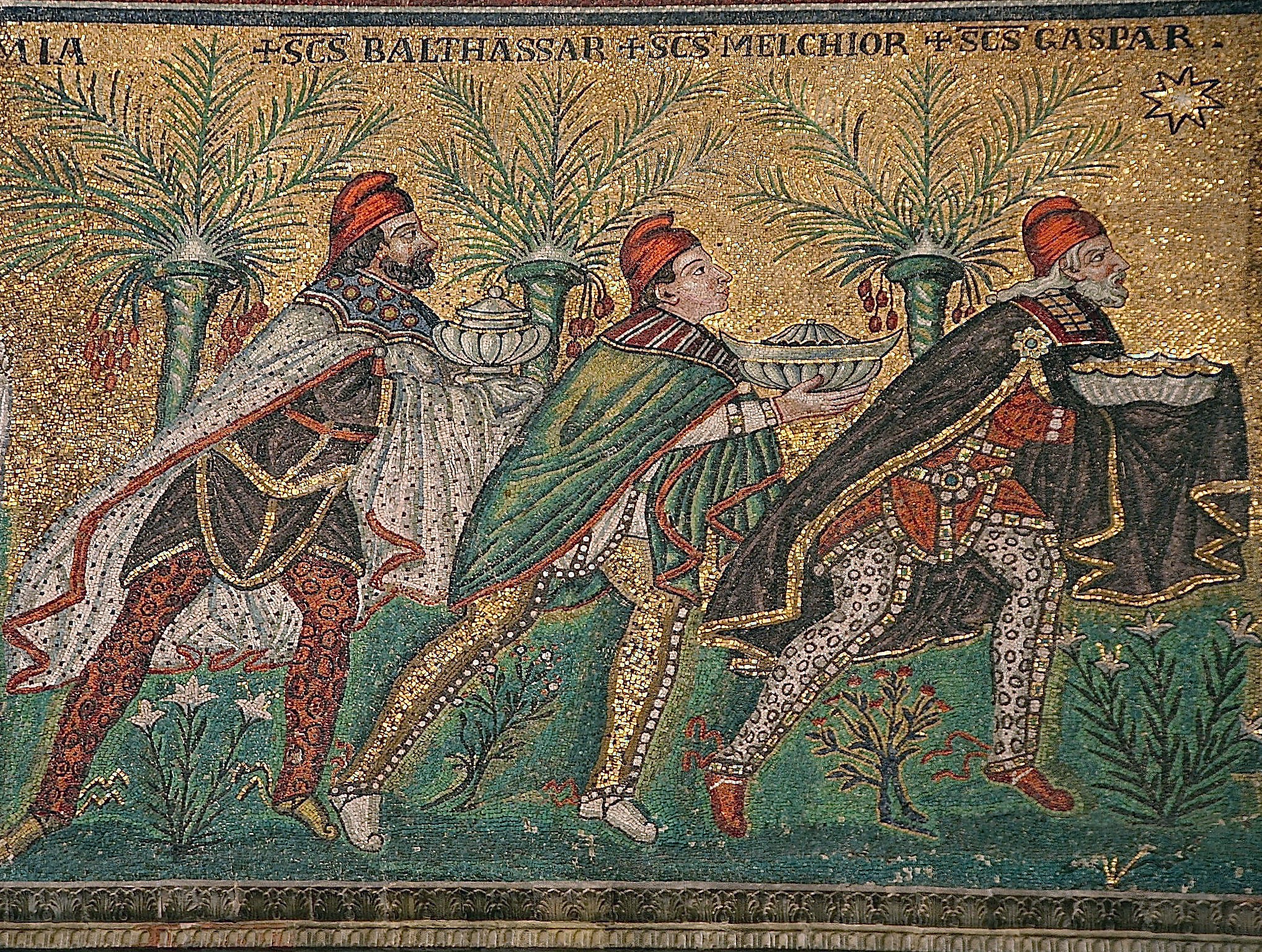
“We three kings of Orient are…” runs the traditional Christmas carol. If you were that kid who wondered “Just who are these guys with their weird-sounding gifts? And where’s ‘Orientare’ anyway?” this blog post is for you.
The story of the Magi originated in the Gospel of Matthew (2:1-12), which tells of “wise men from the east” (magi ab oriente) who traveled to Jerusalem seeking the king of the Jews after seeing a star portending his birth. When they reached Bethlehem, Matthew recounts, they fell and adored him, offering gifts of gold, frankincense, and myrrh. Although this fairly skeletal story offers few details about how the magi looked or from where “in the east” they hailed, that didn’t stop medieval artists from developing their Biblical story into an elaborate visual tradition.
Matthew offers no information about the number of magi who made the trip to Bethlehem. The tradition of depicting them as a trio predominated from the third century onward, perhaps inspired by the three gifts mentioned in the biblical account. Nonetheless, early medieval depictions of the magi in other numbers, such as two, four, or even six, can occasionally be found. Matthew also remains silent about the magi’s names; the ones with which we are familiar today—Melchior, Caspar, and Balthazar—appear much later, in Byzantine texts and images of the sixth century. One of the earliest such instances is the Adoration of the Magi mosaic in Sant’ Apollinare Nuovo in Ravenna, where the elder, foremost magus is labeled Caspar, rather than Melchior, as more often would be the case in later medieval art.
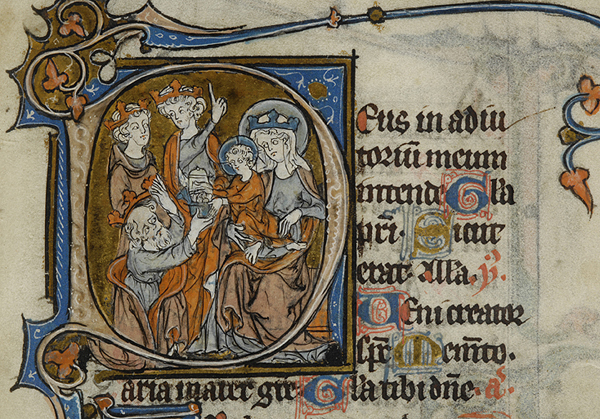
Despite the lack of information about the locations from which the magi came, artists quickly developed ways of visually emphasizing their foreign origins. Early medieval images drew on traditional Roman representations of non-Roman peoples paying homage to the emperor, depicting the magi in appropriately “outlandish” dress such as the short tunics, brightly patterned leggings, and forward-peaked Phrygian caps that appear at Sant’ Apollinare Nuovo. Artistic interest in signaling the magi’s foreign origins corresponded well with Christian exegeses that interpreted the adoration of the magi as symbolic of “heathen” peoples’ recognition of Christ. It was not until the tenth century in western Europe that the magi were reconceived as royal figures, in association with the reference of Isaiah 60:1-4 to the Messiah’s illumination of Gentiles and kings. In many works of art from this point onward, the magi have traded in their traditional caps and trousers for crowns and royal robes, as in the early fourteenth-century Saligny Hours (Morgan Library & Museum, MS. M.60, fol.8r).

From the early Middle Ages onward, the magi were increasingly conceived to be of different ages and geographical origins. In the eighth century, the unknown Irish author nicknamed the “Pseudo-Bede” set down these ideas in writing, describing the magi as of three ages—youth, maturity, and old age—that corresponded to three stages of the life cycle as described by Classical philosophers. Their representation in the ninth-century Stuttgart Psalter (Würtembergische Landesbibliothek, Bibl. Fol. 23, fol. 84r) observes this tradition, depicting them with a white beard, a dark beard, and no beard at all.
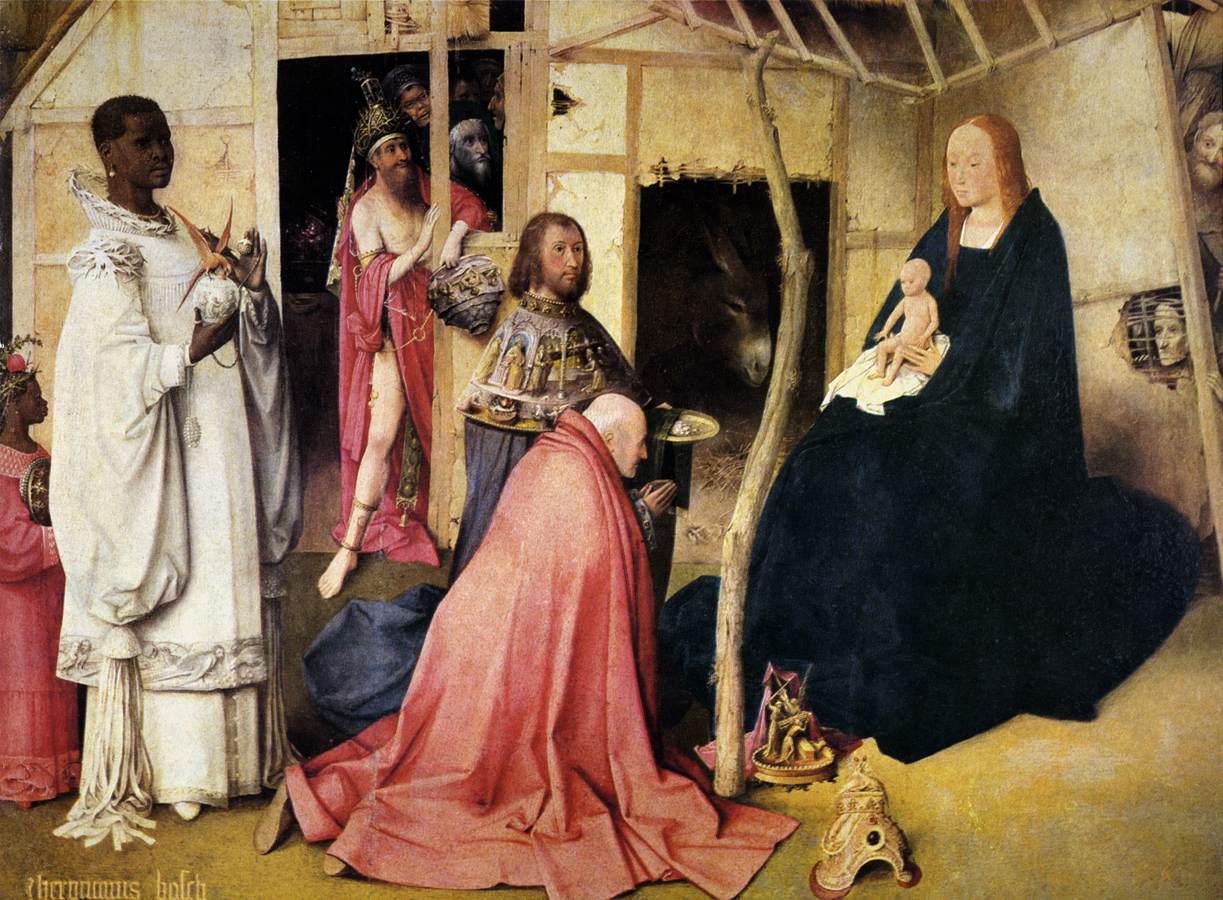
The Pseudo-Bede also described the magi as hailing from the three known parts of the medieval world: Europe, Asia, and Africa. These continents, which formed the basis for the typically tripartite division of medieval T-O maps, were also thought each to have been settled by one of Noah’s three sons, Ham, Shem, and Japeth, with whom medieval thinkers sometimes associated the division of humanity into African, Asian, and European “races.” The late medieval and early modern tradition of representing the magi with ethnic features that European artists tended to associate with each continent—Melchior as a white European, Caspar with Asian features, and Balthazar as a black African—can be traced to this chain of ideas. The opportunity to distinguish the magi as exotic foreigners through their physical appearance as well as through costume and other attributes inspired some of the most elaborate and imaginative portrayals of the later Middle Ages, among them Hieronymous Bosch’s famous 1510 Adoration of the Magi in the Prado Museum. In the Index, many similar images can be found by browsing the subject “Black Magus.”

Extensive image cycles developed around the story of the magi; these illustrate the several stages of their journey, including their questioning of Herod, their sighting of the star, and their arrival in Bethlehem, as well as the dream in which they are warned to avoid Herod and their journey homeward by another route. Over a dozen of these subjects, from “Magi, Adoration” to “Magi, Vision of Christ at Different Ages,” are catalogued in the Index. The most popular subject of all, for medieval and modern viewers alike, is the Adoration of the Magi, depicting the moment when the wise men render homage to the Christ Child in Bethlehem. Portrayals of this event range in both complexity and mood, from the charming, trousered travelers of early Christian tradition to the theatrical processions, replete with angels, gaily costumed servants, and trains of exotic animals (including camels!), of late medieval works like Gentile da Fabriano’s 1423 altarpiece of the Adoration, now in the Uffizi Gallery. Although we still have no idea where these wise guys came from, their presence never fails to bring magic and mystery to the traditional Christmas story.
Someone made each of the works of art described in the Index of Medieval Art, and since the beginning of its online database, The Index has acknowledged the individuals and workshops responsible for generating illuminated manuscripts, sculptures, mosaics, et al. when their identities are known. In the original Index system, artists and scribes each occupied a separate field, however, in the updated Index a new field has been established to incorporate both roles under the title of Creator. This reflects the fact that in some media, such as manuscript illumination, the roles of scribe and artist were not always separate: at times one individual undertook both kinds of work, while in other cases the jobs were more specialized.
The Index here expresses a caveat: Creator will not appear on every record. Medieval artists and scribes were/are largely anonymous, creating unsigned works of art for patrons who were also frequently unknown. However, some of the approximately 1400 creators who are named in the Index are known because they signed their works. Others were acknowledged by patrons who named artisans in their inventories, and still others have been identified by modern art historians who have spotted enough similarities among groups of works to assign a nickname for their otherwise anonymous master.
You can learn more about the artist associated with a particular work of art by looking at the work of art record, where the Creator field is located just toward the bottom. In the example below, a screen shot of a manuscript main record shows the name of Simon Bening as creator.
Click on the name, and another window will open providing information about the creator, including such information as general notes, alternate names, bibliographical citations, profession/s and work of art references. This last bit of information presents a list of all works of art associated by the Index with the artist. In the case of our example Simon Bening, this includes some 250 manuscript folios attributed to the artist and included in our database. The researcher can then click through the records to view these works.

You can also browse by Creator name to see the information and records that the Index includes for a particular Creator. Choose the Browse option on the home page, and from the Browse Indices, click on Creator to open an alphabetical list of names. To find the artist or scribe of interest, either scroll through the list or type the desired name on the line below “Creator” at the top of the list. Click on the correct name, and a window will open as above.

The information about artists and scribes is intended to provide a springboard for further research. Citations frequently include an article in Oxford Art Online, many of which are followed in turn by relevant bibliography.
Although as noted, most medieval artists and scribes are unknown, The Index does include nearly 1400 “named” creators. A significant portion remain personally anonymous, but have been given monikers based on the attribution of works of very similar style or other details, such as the Gold Scrolls Group, named for a distinctive style of ornament, or the Master of Catherine of Cleves, a name based on work created for a specific patron. Searching Grove Art Online for “Anonymous Masters” will yield page after page of unknown creators whose works have been linked in this way to create a body of work by one artist, scribe or workshop. Because many of these names are still in use in art historical scholarship, the Index includes them in the Creator list, sometimes designating them as “see from” terms when consensus about authorship is not clear. We love to keep our records updated, so if you know of new research about the attribution of a work of art, please bring it to our attention at theindex@princeton.edu.
Judith K. Golden
Registration for the Symposium “Eclecticism at the Edges: Medieval Art and Architecture at the Crossroads of the Latin, Greek, and Slavic Cultural Spheres” is now open. The Symposium will be held on April 5-6, 2019 in 106 McCormick Hall on the Princeton University campus. This event is free, but registration is required to guarantee seating.
For details about the Symposium, please check the event web page at https://ima.princeton.edu/conferences/
We look forward to seeing you!
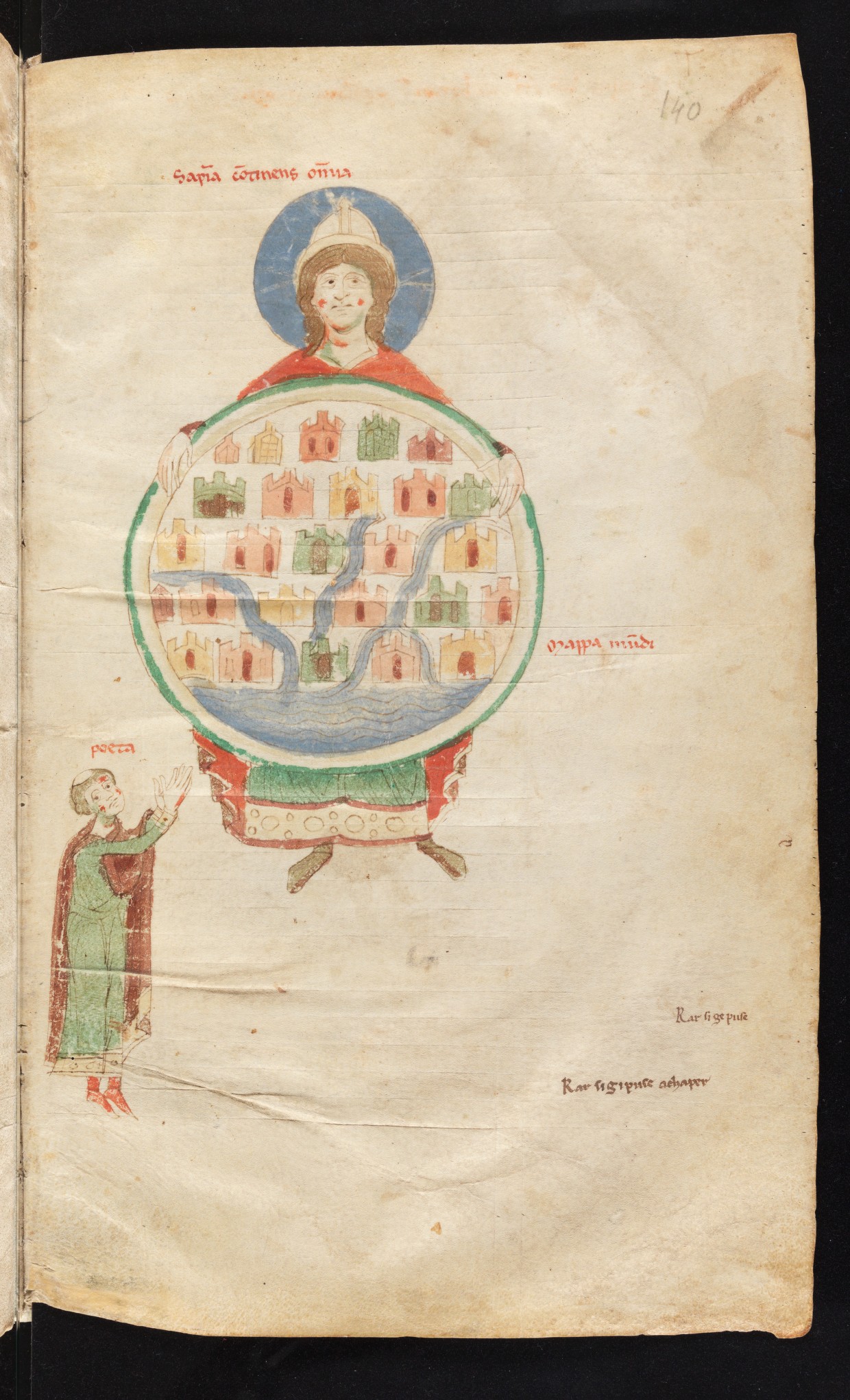
Wisdom holding a Map of the World, from Petrus de Ebulo: Liber ad honorem Augusti (Bern, Burgerbibliothek, Cod. 120.II, fol. 140r)
Registration for the Nov. 17 Index conference “Out of Bounds: Exploring the Limits of Medieval Art” is now open. Lectures will take place in 101 McCormick Hall on the Princeton University campus between 9-5, with a reception to follow in the Palmer House. Registration is free but required to guarantee a seat. For details about the conference, please check the event web page at https://ima.princeton.edu/conferences/. We look forward to seeing you!
Fourth in a series of short blog posts introducing new features of our online database

Did you know that you can filter Index search results by style and/or culture of origin? The “Style/Culture” field on the search filters page groups results according to widely used stylistic or cultural categories, such as “Gothic,” “Ethiopian,” or “Jewish.”
As any student of art history knows, stylistic and cultural labels can be difficult to define. Stylistically speaking, what’s “Gothic” in France in 1150 may be considered “Romanesque” at the same date in Italy, while the parameters for ethnic, religious, or other cultural communities can vary even more dramatically. Still, because we’ve observed that students and other new users of the Index may find such labels helpful in narrowing and exploring search results, we’ve elected to keep them in our new database, consulting authorities such as the Getty Art and Architecture Thesaurus and even current medieval art textbooks to refine how we apply them. If you’d like to learn more about why we applied a particular “Style/Culture” label to a work of art, you can look at the authority record for that label.
Because style and culture terms remain subjective even in the best of circumstances, they may not yield precise results and are most usefully applied when you are searching broadly to learn how a subject was represented in a particular period or cultural sphere, rather than to search for a particular example. You might find, for example, that searching for a frequently represented subject such as “Virgin Mary: Annunciation” delivers an intimidating 2500+ results. However, if what you really wanted was to see examples of how the Annunciation was depicted in Byzantine art, narrowing the results by using the “Style/Culture” delimiter “Byzantine” reduces this to a much more manageable—and more relevant—list of 276 records.
Some delimiters will still deliver a high number of results (try using “Gothic” instead of “Byzantine” to see what we mean), but you can refine these further by using additional filters—such as Date, Location, or Medium—when you’re ready for more specificity. To apply the Style/Culture filter, type a search term into the free text field at the upper right of the search window. On the results page, choose the “Filters” option, then in the “Style/Culture filter, begin typing the term you’re looking for—the system will auto-complete the term, if it exists—and then, once you’ve selected the term you want, simply click “Search.” The filtered results will appear below.
If you’d like to view a complete list of Style/Culture terms currently used by the Index, click on “Browse” at the top of the window and then choose Style/Culture. To expedite your search for a particular term, type it into the search line at the top of the list.
As always, if you have questions or comments about the Index of Medieval Art database, please contact theindex@princeton.edu. We’re here to help, and we want to know what you think.
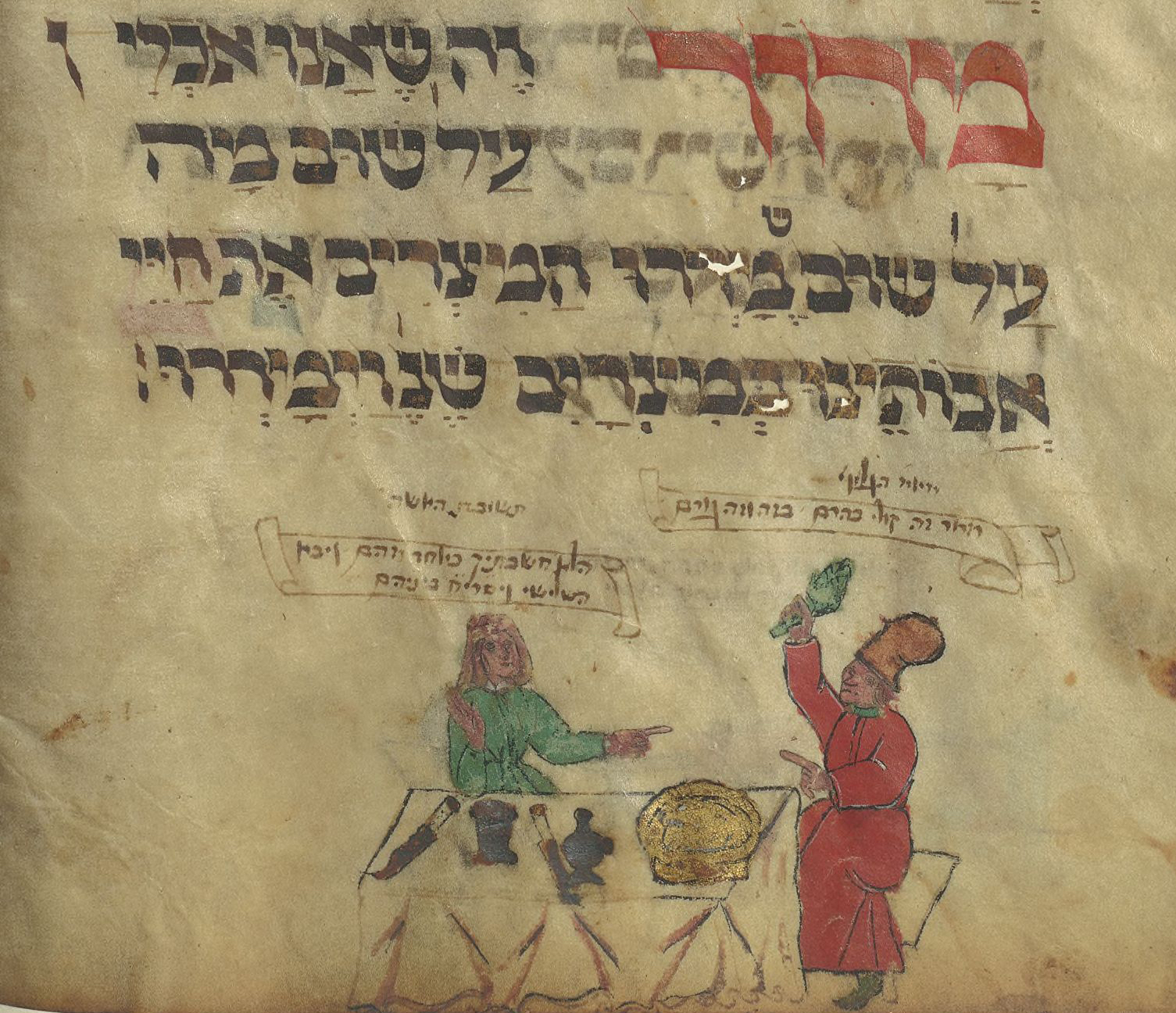
This year’s contributions are unusually diverse, ranging from Byzantine wall paintings and Romanesque sculpture to Ottonian dynastic images and Jewish ritual books. In addition, for the first time this year authors were offered the option to include color illustrations. Check out the contents of the latest volume on the updated journal page: https://ima.princeton.edu/studies-in-iconography/. Congratulations and thank you to all our authors and reviewers!
Studies in Iconography (ISSN 0148-1029) is an annual publication housed at the Index of Medieval Art at Princeton University since October 1999. It is dedicated to publishing innovative work on iconography and other aspects of visual culture of the period up to 1600. We welcome submissions of innovative work on iconography and other aspects of visual culture of the period up to 1600, including those with interdisciplinary, theoretical, and critical perspectives. Submissions are accepted year round; see https://ima.princeton.edu/studies-in-iconography-editorial-guidelines/ for current guidelines.

June, from the Très Riches Heures du Duc du Berry (Chantilly, Musée Condé, 65/1284), fol. 6v © Photo. R.M.N. / R.-G. Ojda
The Index will be closed on June 4 and 5 as Princeton celebrates Class Day and Commencement 2018. We look forward to welcoming visitors during Princeton University weekday summer hours, 8:45-4:30, beginning June 6.